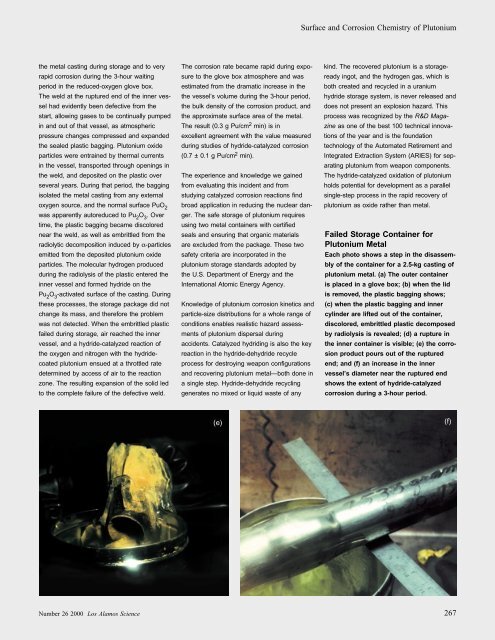Surface and Corrosion Chemistry of PLUTONIUM - Federation of ...
Surface and Corrosion Chemistry of PLUTONIUM - Federation of ...
Surface and Corrosion Chemistry of PLUTONIUM - Federation of ...
Create successful ePaper yourself
Turn your PDF publications into a flip-book with our unique Google optimized e-Paper software.
the metal casting during storage <strong>and</strong> to very<br />
rapid corrosion during the 3-hour waiting<br />
period in the reduced-oxygen glove box.<br />
The weld at the ruptured end <strong>of</strong> the inner vessel<br />
had evidently been defective from the<br />
start, allowing gases to be continually pumped<br />
in <strong>and</strong> out <strong>of</strong> that vessel, as atmospheric<br />
pressure changes compressed <strong>and</strong> exp<strong>and</strong>ed<br />
the sealed plastic bagging. Plutonium oxide<br />
particles were entrained by thermal currents<br />
in the vessel, transported through openings in<br />
the weld, <strong>and</strong> deposited on the plastic over<br />
several years. During that period, the bagging<br />
isolated the metal casting from any external<br />
oxygen source, <strong>and</strong> the normal surface PuO2 was apparently autoreduced to Pu2O3 . Over<br />
time, the plastic bagging became discolored<br />
near the weld, as well as embrittled from the<br />
radiolytic decomposition induced by α-particles<br />
emitted from the deposited plutonium oxide<br />
particles. The molecular hydrogen produced<br />
during the radiolysis <strong>of</strong> the plastic entered the<br />
inner vessel <strong>and</strong> formed hydride on the<br />
Pu2O3-activated surface <strong>of</strong> the casting. During<br />
these processes, the storage package did not<br />
change its mass, <strong>and</strong> therefore the problem<br />
was not detected. When the embrittled plastic<br />
failed during storage, air reached the inner<br />
vessel, <strong>and</strong> a hydride-catalyzed reaction <strong>of</strong><br />
the oxygen <strong>and</strong> nitrogen with the hydridecoated<br />
plutonium ensued at a throttled rate<br />
determined by access <strong>of</strong> air to the reaction<br />
zone. The resulting expansion <strong>of</strong> the solid led<br />
to the complete failure <strong>of</strong> the defective weld.<br />
The corrosion rate became rapid during exposure<br />
to the glove box atmosphere <strong>and</strong> was<br />
estimated from the dramatic increase in the<br />
the vessel’s volume during the 3-hour period,<br />
the bulk density <strong>of</strong> the corrosion product, <strong>and</strong><br />
the approximate surface area <strong>of</strong> the metal.<br />
The result (0.3 g Pu/cm2 min) is in<br />
excellent agreement with the value measured<br />
during studies <strong>of</strong> hydride-catalyzed corrosion<br />
(0.7 ± 0.1 g Pu/cm2 min).<br />
The experience <strong>and</strong> knowledge we gained<br />
from evaluating this incident <strong>and</strong> from<br />
studying catalyzed corrosion reactions find<br />
broad application in reducing the nuclear danger.<br />
The safe storage <strong>of</strong> plutonium requires<br />
using two metal containers with certified<br />
seals <strong>and</strong> ensuring that organic materials<br />
are excluded from the package. These two<br />
safety criteria are incorporated in the<br />
plutonium storage st<strong>and</strong>ards adopted by<br />
the U.S. Department <strong>of</strong> Energy <strong>and</strong> the<br />
International Atomic Energy Agency.<br />
Knowledge <strong>of</strong> plutonium corrosion kinetics <strong>and</strong><br />
particle-size distributions for a whole range <strong>of</strong><br />
conditions enables realistic hazard assessments<br />
<strong>of</strong> plutonium dispersal during<br />
accidents. Catalyzed hydriding is also the key<br />
reaction in the hydride-dehydride recycle<br />
process for destroying weapon configurations<br />
<strong>and</strong> recovering plutonium metal—both done in<br />
a single step. Hydride-dehydride recycling<br />
generates no mixed or liquid waste <strong>of</strong> any<br />
(e)<br />
<strong>Surface</strong> <strong>and</strong> <strong>Corrosion</strong> <strong>Chemistry</strong> <strong>of</strong> Plutonium<br />
kind. The recovered plutonium is a storageready<br />
ingot, <strong>and</strong> the hydrogen gas, which is<br />
both created <strong>and</strong> recycled in a uranium<br />
hydride storage system, is never released <strong>and</strong><br />
does not present an explosion hazard. This<br />
process was recognized by the R&D Magazine<br />
as one <strong>of</strong> the best 100 technical innovations<br />
<strong>of</strong> the year <strong>and</strong> is the foundation<br />
technology <strong>of</strong> the Automated Retirement <strong>and</strong><br />
Integrated Extraction System (ARIES) for separating<br />
plutonium from weapon components.<br />
The hydride-catalyzed oxidation <strong>of</strong> plutonium<br />
holds potential for development as a parallel<br />
single-step process in the rapid recovery <strong>of</strong><br />
plutonium as oxide rather than metal.<br />
Failed Storage Container for<br />
Plutonium Metal<br />
Each photo shows a step in the disassembly<br />
<strong>of</strong> the container for a 2.5-kg casting <strong>of</strong><br />
plutonium metal. (a) The outer container<br />
is placed in a glove box; (b) when the lid<br />
is removed, the plastic bagging shows;<br />
(c) when the plastic bagging <strong>and</strong> inner<br />
cylinder are lifted out <strong>of</strong> the container,<br />
discolored, embrittled plastic decomposed<br />
by radiolysis is revealed; (d) a rupture in<br />
the inner container is visible; (e) the corrosion<br />
product pours out <strong>of</strong> the ruptured<br />
end; <strong>and</strong> (f) an increase in the inner<br />
vessel’s diameter near the ruptured end<br />
shows the extent <strong>of</strong> hydride-catalyzed<br />
corrosion during a 3-hour period.<br />
Number 26 2000 Los Alamos Science 267<br />
(f)
















